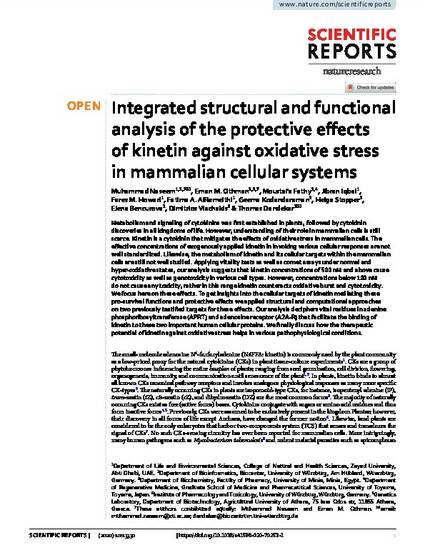
© 2020, The Author(s). Metabolism and signaling of cytokinins was first established in plants, followed by cytokinin discoveries in all kingdoms of life. However, understanding of their role in mammalian cells is still scarce. Kinetin is a cytokinin that mitigates the effects of oxidative stress in mammalian cells. The effective concentrations of exogenously applied kinetin in invoking various cellular responses are not well standardized. Likewise, the metabolism of kinetin and its cellular targets within the mammalian cells are still not well studied. Applying vitality tests as well as comet assays under normal and hyper-oxidative states, our analysis suggests that kinetin concentrations of 500 nM and above cause cytotoxicity as well as genotoxicity in various cell types. However, concentrations below 100 nM do not cause any toxicity, rather in this range kinetin counteracts oxidative burst and cytotoxicity. We focus here on these effects. To get insights into the cellular targets of kinetin mediating these pro-survival functions and protective effects we applied structural and computational approaches on two previously testified targets for these effects. Our analysis deciphers vital residues in adenine phosphoribosyltransferase (APRT) and adenosine receptor (A2A-R) that facilitate the binding of kinetin to these two important human cellular proteins. We finally discuss how the therapeutic potential of kinetin against oxidative stress helps in various pathophysiological conditions.
- adenine phosphoribosyltransferase,
- adenosine receptor,
- kinetin,
- animal,
- HL-60 cell line,
- human,
- mammal,
- metabolism,
- oxidation reduction reaction,
- oxidative stress,
- physiology,
- tumor cell line,
- Adenine Phosphoribosyltransferase,
- Animals,
- Cell Line,
- Tumor,
- HL-60 Cells,
- Humans,
- Kinetin,
- Mammals,
- Oxidation-Reduction,
- Oxidative Stress,
- Receptors,
- Purinergic P1
Available at: http://works.bepress.com/jibran-iqbal/75/